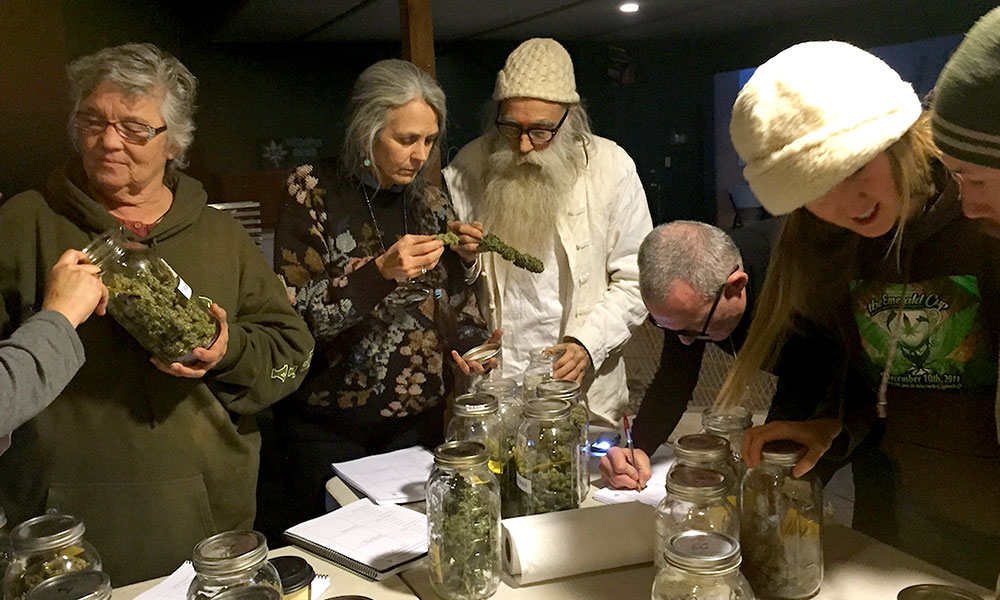Key Takeaways:
- Cannabis flowers exhibit a wide variety of smells and aromas, ranging from gassy and floral to fruity and savory.
- Terpenes play a significant role in determining the aroma profile of a cannabis flower, but they are not the only volatile compounds responsible for the diverse range of smells.
- Other volatile organic compounds, such as esters, alcohols, acids, and phenols, contribute to the overall aroma of cannabis flowers.
- An understanding of these volatile compounds can enhance the appreciation and evaluation of cannabis flowers.
As judges of the prestigious Emerald Cup for almost two decades, we have had the extraordinary opportunity to sample thousands of cannabis flowers from California’s premier cultivation counties. Our olfactory journey through these flowers has revealed an enormous diversity of smells, aromas, fragrances, and stinks that cannabis can offer.
Identifying Aromas
In the early days of the Cup, the entries were primarily dominated by OG’s, diesels, and “chemies” or solvents. However, as the competition evolved, entries with floral and fruity smells started to make their presence known. Categories such as gasses and florals were created to organize the multitude of glass jars on the judging table.
Over the years, we have encountered cannabis flowers that smell like burnt rubber, tar, chlorine, sour milk, garlic, roast beef, roast chicken, mothballs, banana, strawberry, airplane glue, diesel, kerosene, gasoline, pine sol, citrus, guava, vinyl, fresh mown grass, fresh air, jasmine, gardenias, honeysuckle, apple pie, cinnamon, nutmeg, cardamom, lemon, tangerine, grapefruit, orange, pineapple, and many more.
Here are some aroma notes we have for random flower entries in the 2023 Emerald Cup:
- Entry # 1: canned pineapple, Hyacinth, shoe polish, smokey leather
- Entry # 2: watermelon, cherry, redwoods, honey, hyacinth, sage
- Entry # 4: modeling clay, orange juice with fish in it, formaldehyde
- Entry # 7: tar, mango, Doug fir forest, Fabreeze, thyme, eucalyptus
To judge the large number of flower entries effectively, it became evident that categorizing the aromas into distinct groups was necessary. This allowed for a fair comparison between buds with similar smells. However, it raised questions about the measurement and classification of these aroma categories.
THC Potency Isn’t Everything
Contrary to popular belief, the highest THC content does not always determine the winner of the Emerald Cup. Since 2010, the winning entries have consistently shown lower THC levels compared to other competitors.
As a result, many cannabis labs started testing for the dominant terpenes, believing that the highest measured terpene would define the flower’s aroma. SC Labs, in particular, conducted a meta-analysis of their testing data and found that myrcene dominated approximately 40% of the tested flowers, followed by beta-caryophyllene, terpinolene, pinene, limonene, and ocimene in varying percentages.
This discovery shed light on the entourage effect, a concept that suggests the interaction between terpenes and cannabinoids contributes to the overall cannabis experience. It expanded the scientific understanding of cannabis terpenes and their influence on aroma and flavor profiles.
Understanding Terpenes
Starting in 2021, the Emerald Cup entries were categorized based on Phytofacts’ six categories, which revolve around the dominant terpenes. This enabled judges to deepen their awareness of terpenes and their combinations.
In recent competitions, SC Labs measured the two highest terpenes in the entries. However, as the judges evaluated the anonymous flower samples, it became apparent that the diverse range of smells could not be solely attributed to the dominant terpenes. Some samples categorized as “OGs and Gas” displayed floral or fruity notes, while others classified as “Desserts” exhibited gassy or even floral characteristics. The aroma profiles of many samples were a combination of multiple categories.
Furthermore, there are savory smells like grilled or smoked meat, garlic, onion, and burnt aromas that cannot be explained by terpenes alone. Earthy smells such as leather, oak, cedar, mushroom, and chocolate also pose a challenge to terpene-based categorization.
Interestingly, even fruity fragrances like strawberry, banana, and pineapple are not solely derived from terpenes but rather from esters.
While terpenes comprise a significant portion of a cannabis flower’s aroma, it is essential to acknowledge that other volatile organic compounds are present and contribute to the overall scent profile. These compounds, such as alcohols, acids, phenols, thiols, and benzenoids, work in conjunction with terpenes to create a bouquet of aromas.
Taking It Further: The Aromatics of Cannabis
Plants produce aromas to attract or repel other organisms. These aromas are composed of volatile organic compounds, or “The Aromatics.” The fragrance emitted by a plant is rarely the result of a single volatile compound or aromatic.
Kev Jodhry, organizer of the Golden Tarp Awards 2014, divided the entries into four distinct “categories of perception”: Floral, Fruit, Earth, and Fuel. This categorization stemmed from Jodhry’s years of experience in growing, breeding, selling, and smelling cannabis. Dr. John Abrams, a scientist from UCLA, corroborated the four categories’ validity after analyzing the contest’s lab data.
In the book “Nose Dive” by Harold McGee, the author delves into the world of volatile organic compounds and their corresponding aromas. McGee’s extensive research highlights the complex nature of aromas, encompassing a wide range of smells from animals, plants, and other sources.
Cannabis plants can produce various volatile organic compounds, including alcohols, acids, phenols, esters, and thiols. These compounds, combined with terpenes, contribute to the diverse array of smells found in different cannabis cultivars.
Understanding the role of these volatile compounds enhances our appreciation and evaluation of cannabis flowers. It provides a more comprehensive understanding of the complexity and uniqueness of each strain’s aroma profile.


